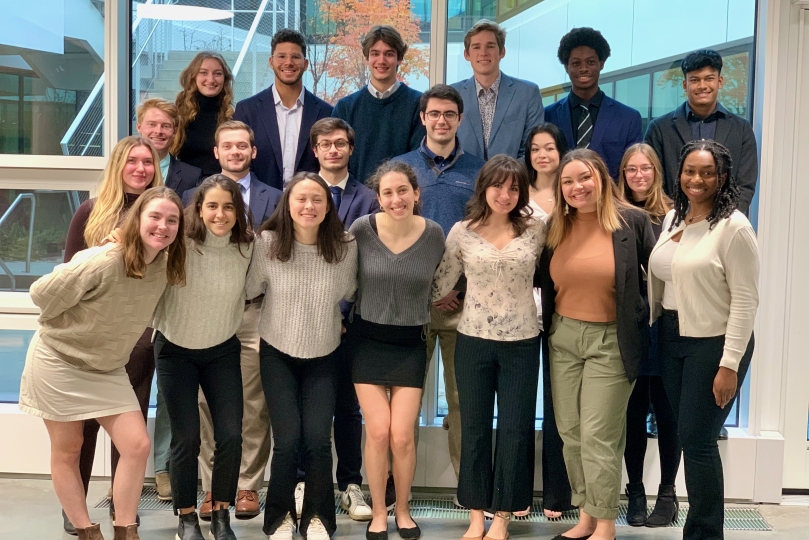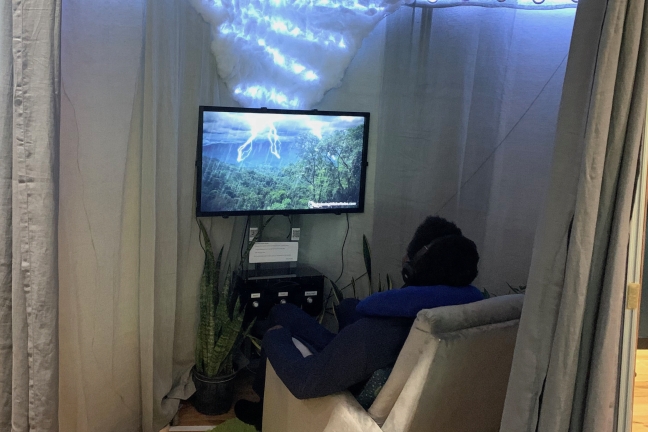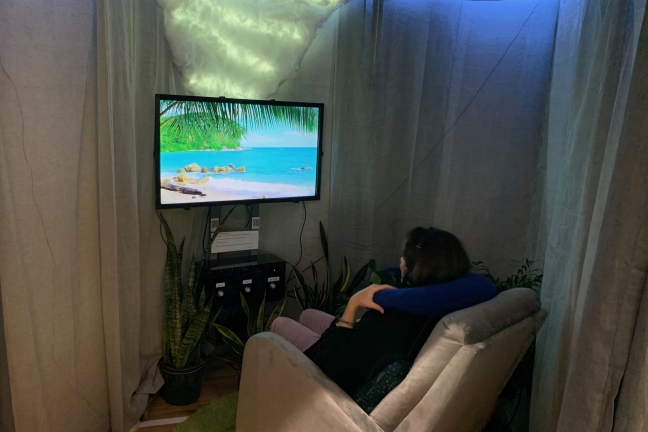News
The Fall 2022 section of "ES96: Engineering Problem Solving and Design Project" worked with Harvard University Health Services and Counseling and Mental Health Service to promote mental health and wellness on campus. (Matt Goisman/SEAS)
Harvard students have a lot to do. Classes, labs, homework, jobs, clubs or teams – it’s natural to feel stressed or overwhelmed. When that happens, offices such as Harvard University Health Services (HUHS) and Counseling and Mental Health Service (CAMHS) can help.
The challenge can be determining the best resource to address a specific need. Trying to navigate all the available resources across campus, which range from peer counseling to medical prescribers to urgent care, can be daunting for students, adding to the stress instead of reducing it.
Students in “ES96: Engineering Problem Solving and Design Project,” at the Harvard John A. Paulson School of Engineering and Applied Sciences (SEAS) spent their fall semester working with CAMHS as a client to address both mental wellness on campus and the challenges CAMHS and students face finding the wellness resources to promote it. ES96 is a core course for third-year SEAS students pursuing S.B. degrees.
“When you have all these resources for sometimes overlapping problems, it can get confusing and cluttered, and trying to navigate between them can be a pain,” said project co-lead Brice Austin. “Hopefully, as we increase access to these resources, people start using them more, and we play a little part in helping reduce mental health issues here.”
Twenty SEAS students worked on three products that were recently presented to CAMHS representatives at the Science and Engineering Complex: a Rest Calculator application, which allows students to input their total number of class and work hours and get recommendations for mental rest breaks; a Resource Navigator app, in which students input their symptoms and reasons for their stress, then recommends specific resources on campus; and an immersive room that uses soothing lighting and sounds to promote relaxation.
“In previous classes, I got used to being able to have the answer,” said Ella Serrano-Wu. “In a lecture class, they give you the material, you practice it on homework, and then you know what to expect on the test. This class is something where you don’t have the answer, so it’s a great exposure to engineering in the real world. No one’s going to have the answers for you. You have to figure it out as you go and use your resources around you.”
The group’s final products concluded three months of research, design, and ideation. Their process began with numerous interviews with CAMHS and HUHS health providers and educators, as well as other students. From there they created a timeline charting the mental health scene on campus, from initial outreach to the interconnected web of campus resources to potential community referrals. Through this process, the students decided their challenge was to address supply and demand issues such as long wait times for campus mental health services.
“You wouldn’t assume mental health and engineering would come together, but we made it possible throughout the course of the semester,” said Mia Wright, who helped design the immersive room. “The team has put a lot of effort into it, and we’ve definitely learned a lot about the whole process of creating a product, especially coming up with our own problem statement.”
The immersive relaxation room designed by members of the Fall 2022 section of "ES96: Engineering Problem Solving and Design Project." (Matt Goisman/SEAS)
As students themselves, the ES96 team experienced some of the same stresses that their project hoped to reduce. That brought an extra level of personal connection to the task, as several members said they hadn’t realized how many resources were available to them before undertaking this project.
“Almost anyone here could relate to some degree to having a stressful experience and not knowing exactly what resources to consult,” said Layla Seaver, part of the Rest Calculator team with Serrano-Wu. “One thing we could all empathize with is the struggle from COVID-19, understanding what resources were even available to us when some of us were learning at home or on campus but not fully on campus. The goal of this is to help students with their mental health.”
The final presentation drew a strong positive reaction from Barbara Lewis, Chief of CAMHS, and colleague Tara Cousineau. The two worked with the class throughout the semester, as did HUHS and Harvard Center for Wellness and Health Promotion representatives.
“I was really impressed when they came up with a problem statement so quickly after interviewing people across HUHS and CAMHS,” Lewis said. Added Cousineau, “It was really comprehensive. We got to see the idea from the inception, how they sorted the whole process, how teams split up into their three different charges and then brought it all together. I was completely impressed. I didn’t expect this level of formative research, testing on students and giving us feedback. It was really a class act.”
Learning to define an open-ended problem is just one of the critical skills students gain from ES96, which for many is the largest - and sometimes only - group project course through their first two-plus years on campus. The course also teaches communication, not only with a client, who might not have an engineering background, but also with engineers from other disciplines and concentrations, who might draw on completely different skills.
“We all learned a lot about communicating with each other, especially being from such diverse engineering backgrounds,” said project co-lead Nicole Prescott. “I think we were all able to really accurately showcase all of our skills.”
With six different engineering disciplines represented in the class, students had to not only try to draw on many different skills, but to do so with a solution that could be delivered in one semester. Feasibility proved to be a critical factor in helping them decide which initial ideas to reject, pursue or combine, leading to the eventual three-part project.
“For every project you’ll ever do in the real world, there’s never enough time, and there’s never enough money,” said David Mooney, Robert P. Pinkas Family Professor of Bioengineering. Mooney co-taught the course with Samir Mitragotri, Hiller Professor of Bioengineering and Hansjorg Wyss Professor of Biologically Inspired Engineering, and teaching fellows Emily Roloson and Alex Gottlieb.
“That’s the essence of engineering: not only what can be done, but what can be done in a meaningful and tactical way,” said Mitragotri.
For more information on CAMHS and the mental health and wellness resources available on campus, check out:
CAMHS Cares 24/7 support line: 617-495-2042
Topics: Academics
Cutting-edge science delivered direct to your inbox.
Join the Harvard SEAS mailing list.
Press Contact
Matt Goisman | mgoisman@g.harvard.edu





